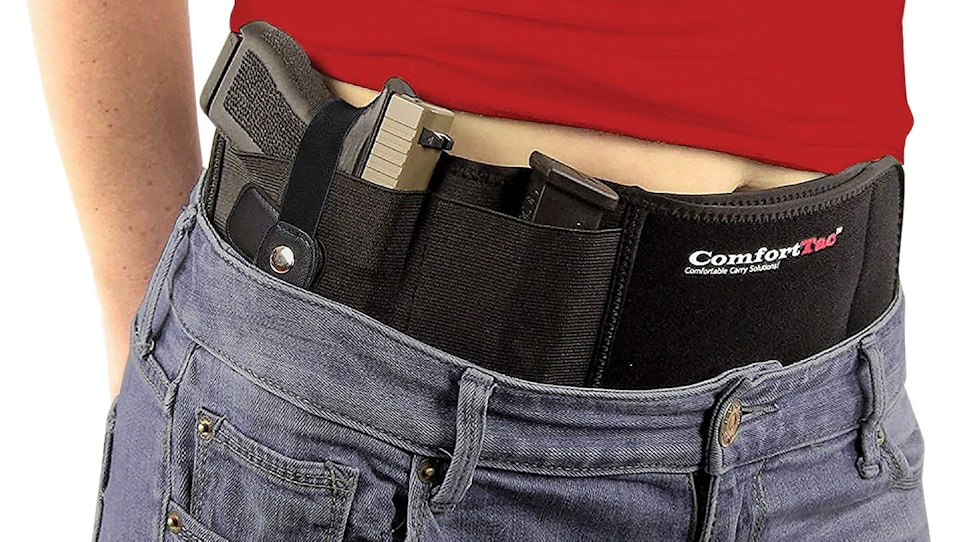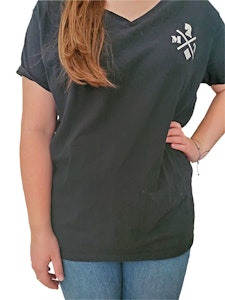For several years, the market for concealed carry firearms and related gear such as holsters has grown and grown and grown. In many cases, the firearms have gotten smaller, more reliable, and higher capacity. Likewise, the holsters meant to safely carry these firearms have also enjoyed a round of innovation and are finding newer ways into or around or onto the bodies of those who carry. By definition, concealed carry only requires the hiding of a firearm from view — including a setup as simple as draping a shirttail over a firearm holstered inside the waistband on a gun belt. But some concealed carry scenarios demand a more deeply hidden firearm, many of which hide a firearm very well but require sacrificing speed of draw or ease of access. Here’s what you need to know and how you can help customers who are wrestling through the pros and cons of five deep-cover concealed-carry options.
Belly Band
Arguably one of the oldest forms of deep cover concealed carry, belly bands — so named because they wrap around a belly, under any other clothes — provide several on-body locations for carrying one or more guns. Early belly bands were merely long strips of fabric that when wrapped around someone offered numerous places to tuck a gun. Modern belly bands built on that idea and added sewn-in holsters, hook-and-loop closures and elastic fabric for comfort and stability. The best belly bands come in soft, flexible fabrics such as neoprene, offer additional padding on the body side of the band or holster, and may even include an adjustable shoulder strap to help carry the weight of additional gear or larger, heavier firearms. “Belly band” is somewhat of a misnomer, as most are meant to be worn over the hips — but most can be hiked up higher, around the belly, if needed.
As with anything wrapped around one’s belly or torso, belly bands can be uncomfortable or even make it difficult to breathe. Hot climates may result in more sweating. Cold climates may require additional layers, making the gun more difficult to access. And, as with most deep-cover carry solutions, hugs may not be an option, as the bulk of a firearm could be discovered when physically touching another person. But for some, the advantages of carrying a concealed firearm in a belly band are many and include the ability to carry discreetly in a T-shirt or other typical hot-weather garments and the ability to carry a second handgun, at least one reload, a tactical flashlight, or other gear. In fact, the additional gear can help balance out the weight of a belly band.
Some manufacturers have also produced a form of belly band meant to be worn on the hips, hidden under a pair of pants or shorts. The holster and gun are meant to carry in the front of a wearer, directly below the waistline. For men, this allows for concealed carry without a shirt, requiring a draw stroke that looks like a wearer is reaching down into the front of his shorts. While this may be the ideal hot climate or beach setup, it can also be worn with most other outfits.
Holster Built Into Outerwear
In scenarios where wearing a jacket or other outerwear is normal, the options for concealing a carry gun increase. Not only do some jackets have multiple pockets, including larger pockets, but they also add another covering layer for a firearm carried in more traditional fashion, such as holstered inside or outside the waistband.
Some outerwear manufacturers have innovated concealed carry by creating a dedicated place to hide a holstered handgun. Often this takes the form of a zippered pocket located at access points at one or both front edges, usually right next to the normal zipper that draws the two edges of a jacket together. Unzipping one of the access points of a concealed carry jacket reveals a wide opening, allowing a hand to access a holstered handgun inside. The holster often takes the form of an elastic band stitched to a panel that attaches to the inside of the hidden compartment via hook-and-loop closure. This allows the user to place the holster and handgun in any number of places or angles inside the pocket, maximizing comfort and concealment based on the gun carried. Some jackets have two hidden compartments and a holster in each, allowing for right- or left-hand carry or two-gun carry. Additional features on these kinds of jackets may include a zippered compartment that locks with a key, loop patches for badges or other forms of ID when necessary, and more.
Drawbacks to these types of holstering systems include the inadvisability of taking the jacket off, because the gun would then be off body, out of the user’s control.
Holster Built Into Pants
Some concealed-carry clothing manufacturers build a holstering/carrying system into a pair of pants. Some accomplish this by creating larger front traditional or cargo pockets meant to handle a gun carried in a pocket holster. Another option is pants that tear away or release at the pocket to allow for access to and drawing of a gun carried in a special built-in holster near the inner thigh, or pants that feature a hidden zipper to access a special built-in holster at the outer thigh.
The main disadvantages to pants like these may include the need for multiple pairs or the limitation of colors or styles — usually they come only in navy, khaki or black as a traditional-looking trouser or chino. A user’s build and the size of handgun carried may place some limitations on this type of deep cover carry as well.
Holster Built Into a T-Shirt
Similar to a belly band, a T-shirt with a built-in holster carries a handgun around a user’s torso, usually under the armpit, similar to the location of a handgun carried in a shoulder holster. A T-shirt so equipped often sports two elastic holsters, one on each side offering a draw using the hand from the opposite side on which the gun is carried. Some of these T-shirts offer a second smaller pocket, meant for a reload or other gear, in front of the gun pocket. The elastic holsters generally are universal fits for many handguns and may offer a elastic retention strap. A typical setup for a right-handed user would be a handgun in the left holster — drawn with the right hand — and a reload in the right holster.
Early T-shirt fabrics included plain cotton, which resulted in holstered guns flopping around a bit. Modern T-shirt fabrics switched to a stretchy material that form fits to a wearer. This provides greater stability for the guns and gear carried. T-shirts with holsters offer very good deep cover concealability, as the guns and gear carried are located under a wearer’s arm. The larger the gun, the more likely the grip will print at the front of the shirt, but this can be hidden by wearing shirts with a pattern or adding a jacket or vest.
Drawing a handgun from a holster-equipped T-shirt is complex, as all these deep cover carry options are, but it can be mastered quickly. If the wearer has a button/dress shirt as his or her covering layer, consider replacing traditional buttons with snaps or some kind of magnet or hook-and-loop closure to provide faster access.
Holsters Built Into Boxer Briefs
Boxer briefs made from stretch fabric with sewn-in holsters and retention straps provide deep cover concealment for those who want a stable, integrated carry solution to keep a handgun in a traditional draw location. Because there’s no holster or clip or belt strap, a wearer can tuck in their shirt over the gun to maximize concealability. And because the pants or shorts are completely separate from the gun, they can be worn with or without a belt, maximizing comfort.
The main drawback to this type of deep cover carry is the propensity for printing, especially when bending over.
As with most tactical gear solutions, the key to selling any of these deep cover options is to know your customers — their goals and limitations based on state laws, department policies and actual use scenarios.
Another Option: A Garment to Cover Traditional Concealed Carry
Moya Tactical is making what the company calls “the first concealed-carry shirt with antiprint technology,” designed for first-time concealed carriers or anyone who is concerned about printing. They are simple shirts — T-shirt or polo style are available — with a clever band of every-so-slightly raised diamond shapes on the inside of the shirt around the waist where the outline of an IWB-carried gun might normally be discernable. The pattern somehow breaks up the shape just enough to disguise it, and you won’t notice the pattern from the outside of the shirt other than perhaps a casually wrinkled look. And the shirts are made in the USA.







